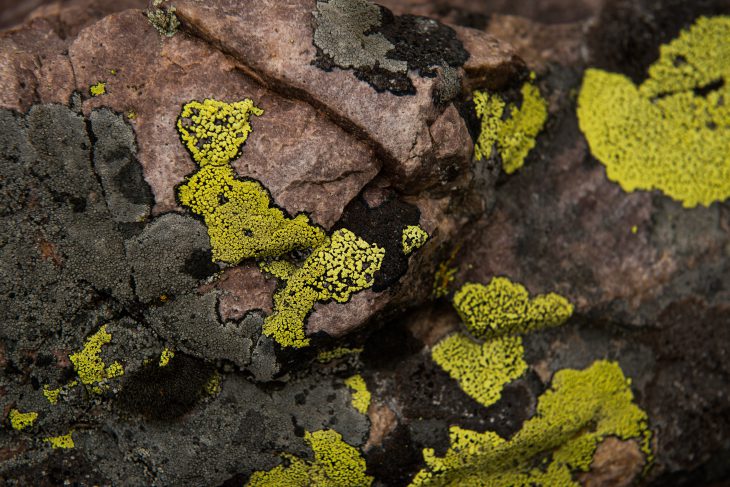We often think of strong winds and waves as the forces that erode the mountains and rocks around us, but there is an entire world of erosion taking place at a microscopic scale. Far less visible to the human eye, microbes play a large role in the breakdown of rocks and minerals.
Like humans, microbes need energy to live and grow. Microbes can get that energy by “eating” one material—nutrients or metals like iron—and by “breathing” another—oxygen or other chemical compounds like nitrate. As they do this, microbes transfer electrons from the metal to the oxygen in a set of processes called reduction and oxidation. Together, these processes provide the energy needed to support life.
Mineral-eating microbes known as chemolithotrophs can have a big impact on the geologic world. Some chemolithotrophic microbes can get their energy directly from the oxidation of rock-forming minerals. Many plants, fungi, and other microbes contribute to the breakdown of rock through the production of acid. However, we don’t know very much about how chemolithotrophs break down rock. Chemolithotrophs have been observed breaking down minerals in the ocean, but does that ability extend to land?
Researchers from University of Wisconsin, University of Bristol, and Pennsylvania State University wanted to understand how these mineral-eating microbes break down bedrock, the layer of solid rock underlying soil in the Earth’s crust. Iron-eating microbes are a common type of chemolithotroph and were targeted in this study. The researchers identified a site in Puerto Rico where the iron-rich granite has experienced a large amount of erosion, believing this rock would contain iron-eating microbes.
To learn what microbes might be present, samples were taken from the broken-down rock lying closer to the surface. The researchers then brought the microbe and rock samples back to the lab. Their goals were to find out if the microbes could break down each rock type, and then learn the chemistry behind how they do it.
In the lab, the researchers set up experiments to observe how the microbes responded to the chemical makeup of the rock. They added small pieces of granite to bottles, with and without microbes. They were expected to be slow-growing organisms. So, to observe the microbes’ effects on erosion, they incubated the samples for a total of two and a half years. Samples were taken immediately after incubation, as well as eight times over the course of the experiment. From these samples, they measured silicon, organic matter, and metals in the surrounding solution to see what, if anything, the microbes liberated from the rock.
As the microbes grew and multiplied in the culture, the surface of the granite pieces became rough — an indication of erosion. Under the microscope, they noticed a grainy buildup on the surface of multiple pieces of granite. Imaging software revealed this buildup to be iron oxyhydroxides, which they hypothesized were waste products generated as the microbes consumed the iron in the rock. Chemical analysis also revealed that a large amount of silicon was removed from the granite. More silicon was released into the solution when the microbes were present, so the researchers surmised that this increase was linked to microbial activity.
In samples without microbes, the researchers observed that a range of metals commonly found in granite–like magnesium, calcium, and sodium– were released from the rock. This indicates normal physical erosion, where the entire rock breaks down, releasing all of its components into solution. In the microbe-rich experiments, iron and silicon were the only major elements released during the experiment. Because the microbes selectively use iron-silicate minerals as an energy source, iron and silicon are the only metals that eroded away
With their experiments, the researchers demonstrated that iron-eating microbes do, in fact, contribute to the breakdown of the rocks around us. This study provides some understanding of how the microbial and geologic worlds interact. Because this study only focuses on iron-eating microbes, more work will be needed to describe the role of microbes that consume other rock components, such as manganese and sulfur.


